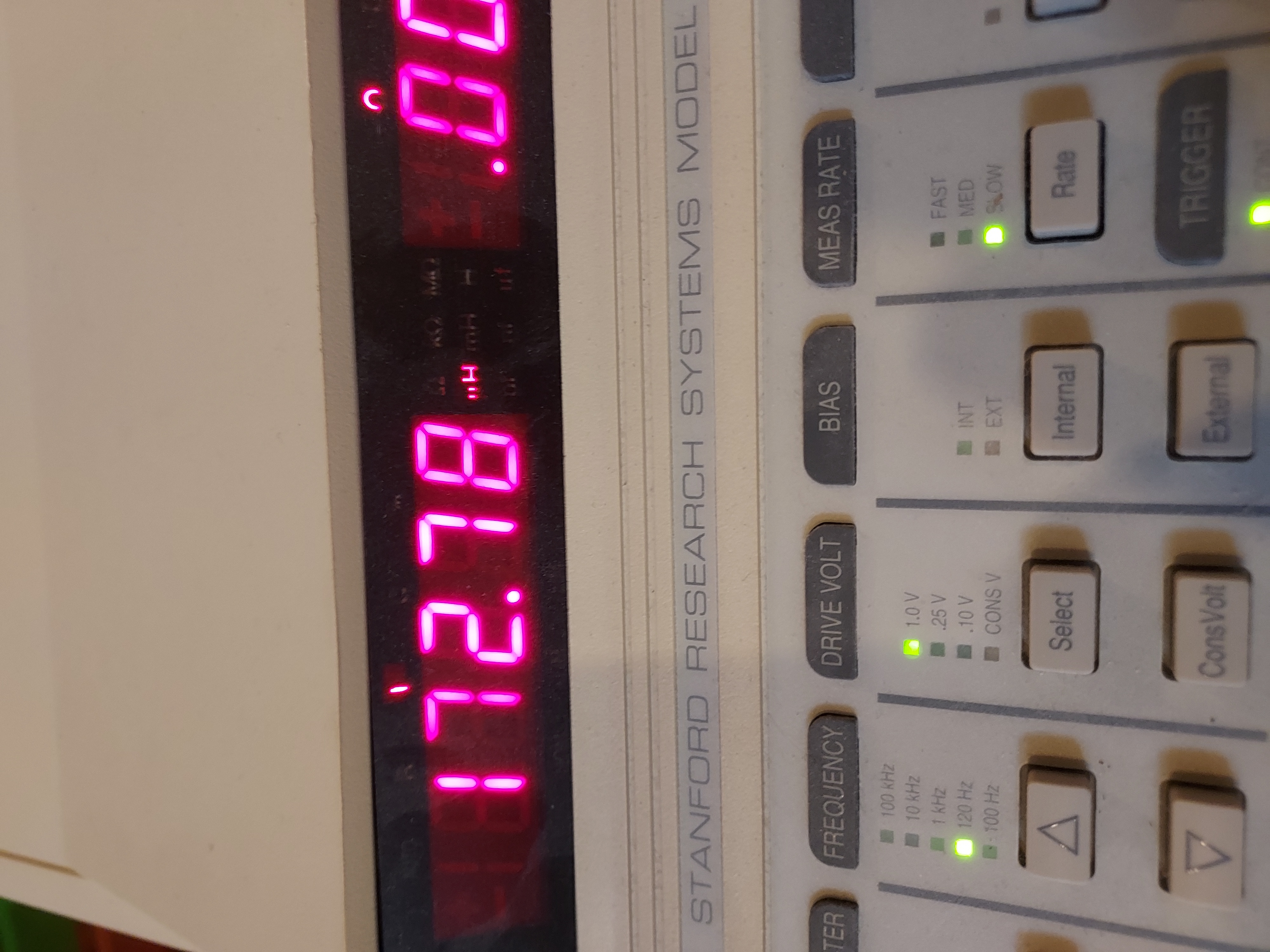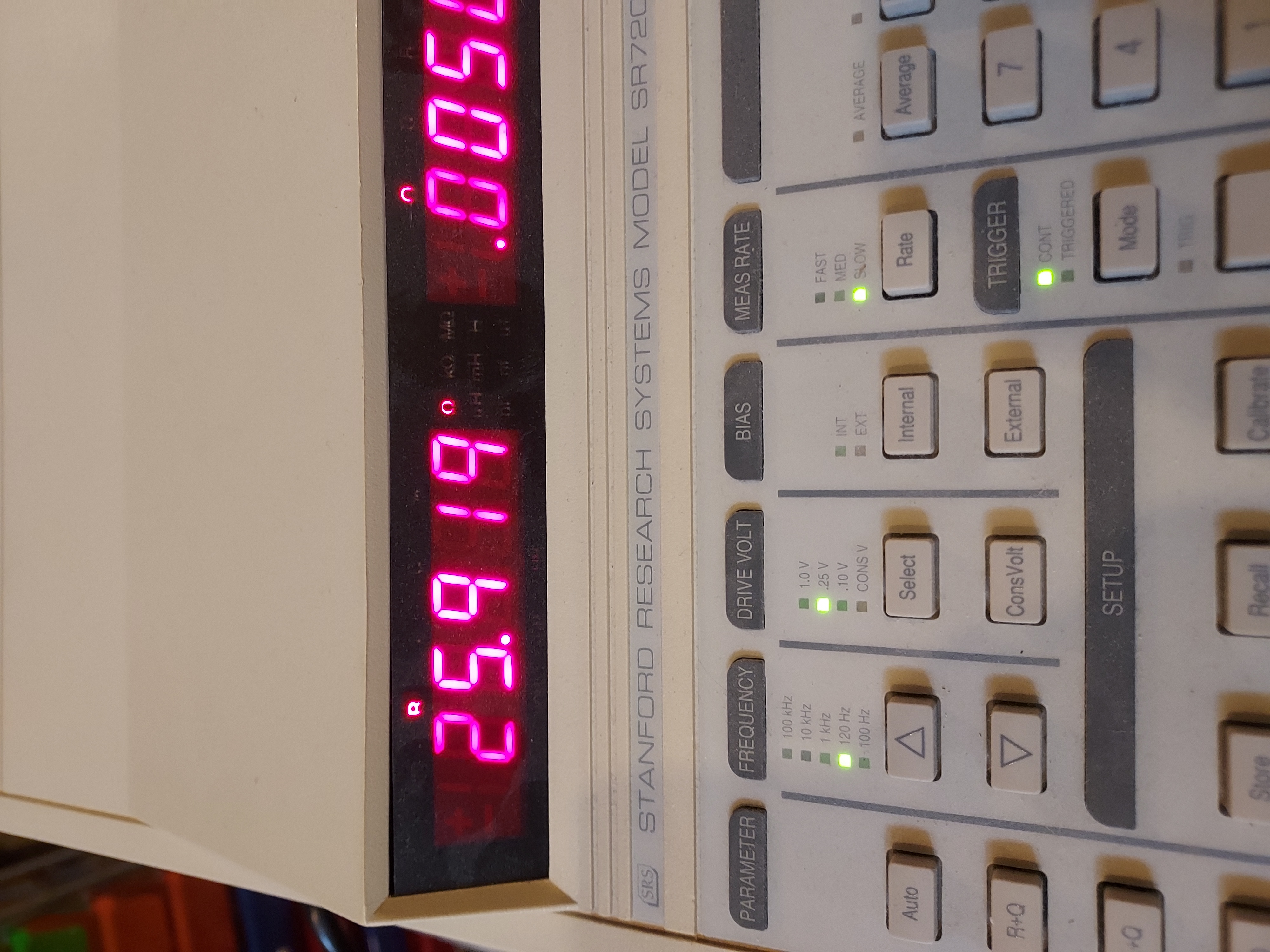03-18-2023, 01:43 PM
DId a little experiment.
I took a 20mm bobbin (shell from a capacitor), took AWG40 wire (seems like it is AWG40 in that coil) and put 100 turns of it, makin about 2cm-long coil.
Then I put it on my LCR meter (Stanford Research) and tried to extrapolate the results to 17,000 turn coil with the same more or less average diameter.
The Average radius of the RCA coil is 9.8mm, which is the same as the coil i made (10mm).
This is the way the coil looks (right lowe part) and the measurement of L+Q.
As the experiment has shown, the result did not depend on the driving voltage or the frequency (100Hz-120kHz)

Close-up

And the DCR

So the 100-turn coil with 10mm radius of the AWG40 wire is 173uH, 26 Ohm.
Now my calculations showed 17,000 turns. This makes it 170-square times the result for L, which is 4.9H and 170 times for R, which is 4,420 Ohm DCR.
Of course this is pretty approximate. I also think the wire might be AWG39 which would account for 4.4K (AWG39 would make it 3.5K which is closer to 3K).
So. I was hoping that the inner end of the AWG40 wire coil that I bought would be accessible, and I'd be able to measure the whole coil inductance, but it is not, so I had to make that coil.
Now, I decided to go to the on-line inductance calculator I used (the one whose image I gave here) and put in my inductance and see what it would give me for my coil.
I put in the diameter, the required inductance, AWG and the length, and it gave me 114 turns (mine is 100) and 25.4 Ohms (mine is 26 Ohms).
Not too bad. When I put my RCA coil's parameters, it is, as before, 2.3H. If it were 100 turns put in, the L would be 133uH.
The other calculator gave me 130uH for my 100-turn inductance, pretty close to 133uH.
So,
1. These calculators are not that far off.
2. Indeed my RCA coil is at least between 2H and 3H.
So I know more or less what they used. A roughly 3H inductance with 3,000 Ohms DCR.
I took a 20mm bobbin (shell from a capacitor), took AWG40 wire (seems like it is AWG40 in that coil) and put 100 turns of it, makin about 2cm-long coil.
Then I put it on my LCR meter (Stanford Research) and tried to extrapolate the results to 17,000 turn coil with the same more or less average diameter.
The Average radius of the RCA coil is 9.8mm, which is the same as the coil i made (10mm).
This is the way the coil looks (right lowe part) and the measurement of L+Q.
As the experiment has shown, the result did not depend on the driving voltage or the frequency (100Hz-120kHz)
Close-up
And the DCR
So the 100-turn coil with 10mm radius of the AWG40 wire is 173uH, 26 Ohm.
Now my calculations showed 17,000 turns. This makes it 170-square times the result for L, which is 4.9H and 170 times for R, which is 4,420 Ohm DCR.
Of course this is pretty approximate. I also think the wire might be AWG39 which would account for 4.4K (AWG39 would make it 3.5K which is closer to 3K).
So. I was hoping that the inner end of the AWG40 wire coil that I bought would be accessible, and I'd be able to measure the whole coil inductance, but it is not, so I had to make that coil.
Now, I decided to go to the on-line inductance calculator I used (the one whose image I gave here) and put in my inductance and see what it would give me for my coil.
I put in the diameter, the required inductance, AWG and the length, and it gave me 114 turns (mine is 100) and 25.4 Ohms (mine is 26 Ohms).
Not too bad. When I put my RCA coil's parameters, it is, as before, 2.3H. If it were 100 turns put in, the L would be 133uH.
The other calculator gave me 130uH for my 100-turn inductance, pretty close to 133uH.
So,
1. These calculators are not that far off.
2. Indeed my RCA coil is at least between 2H and 3H.
So I know more or less what they used. A roughly 3H inductance with 3,000 Ohms DCR.
People who do not drink, do not smoke, do not eat red meat will one day feel really stupid lying there and dying from nothing.



![[-] [-]](https://philcoradio.com/phorum/images/bootbb/collapse.png)


